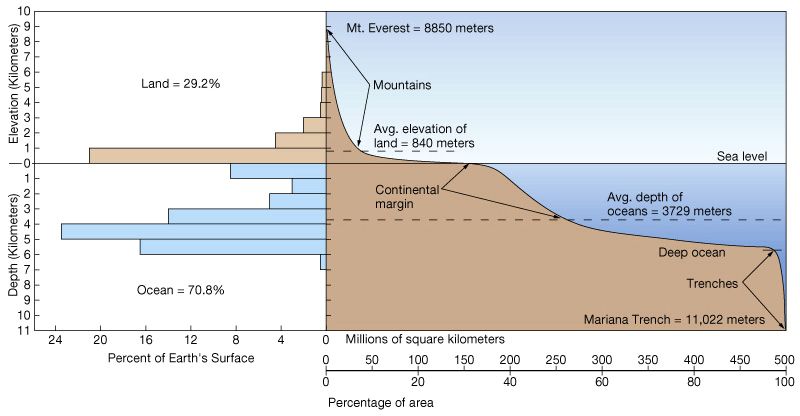 The surface of our planet varies greatly in altitude. In fact about ¾ are covered by seawater, whose average level has been conventionally chosen as a reference for the surface elevations. The statistical analysis of the elevations of the earth’s surface shows us something interesting: the highest percentage of the elevations is around two particular values that are the average level of the ocean floor (about -3790) and the average level of the emerged lands (about 840 m).
The surface of our planet varies greatly in altitude. In fact about ¾ are covered by seawater, whose average level has been conventionally chosen as a reference for the surface elevations. The statistical analysis of the elevations of the earth’s surface shows us something interesting: the highest percentage of the elevations is around two particular values that are the average level of the ocean floor (about -3790) and the average level of the emerged lands (about 840 m).
On the relative graph of the percentage distribution of the areas with respect to the altitudes, called “hypsographic curve”, it can be noted that the portions of surface that reach the minimum altitudes (about -11000 m of the Mariana Trench) and the maximum ones (8850 m of Mount Everest) are a very small fraction of the total.
In a nutshell, the mountain ranges are almost an exception, as are the oceanic trenches, on the surface of the Earth. They appear in so-called belts, which are considerably more developed in one direction than in the other. But what is it that keeps them standing at such exceptional altitudes compared to most of the land above ground?




 The word virus comes from the Latin term for poison. I mean, that’s not a good start. Most people don’t believe that viruses are a life form. In biology, living things are divided into 5 kingdoms: bacteria, protists, fungi, plants, animals. Viruses are not included because they lack a fundamental characteristic of living beings: the ability to reproduce by themselves. Put a virus on a table and don’t let it get in contact with anyone and it stays there without moving or changing. But in contact with the right cell, there it “animates”, reproduces and spreads. Then it can be trouble. But the luck lies in the fact that viruses are extremely specialized: a given virus only attacks certain types of cells of certain living beings. And it can also be useful to human beings…
The word virus comes from the Latin term for poison. I mean, that’s not a good start. Most people don’t believe that viruses are a life form. In biology, living things are divided into 5 kingdoms: bacteria, protists, fungi, plants, animals. Viruses are not included because they lack a fundamental characteristic of living beings: the ability to reproduce by themselves. Put a virus on a table and don’t let it get in contact with anyone and it stays there without moving or changing. But in contact with the right cell, there it “animates”, reproduces and spreads. Then it can be trouble. But the luck lies in the fact that viruses are extremely specialized: a given virus only attacks certain types of cells of certain living beings. And it can also be useful to human beings…